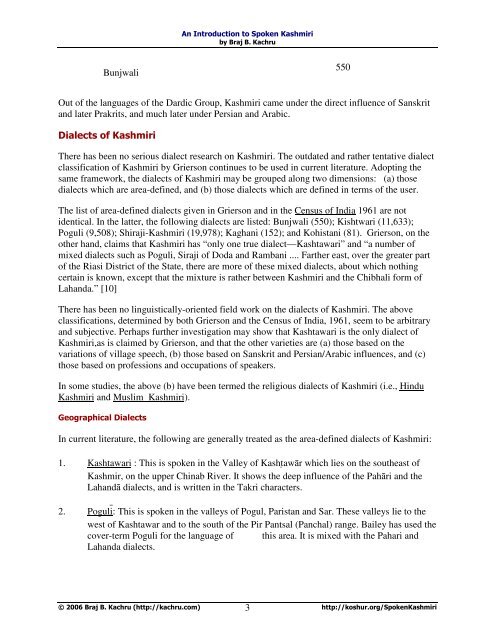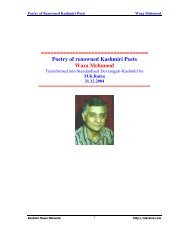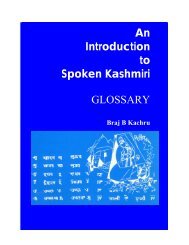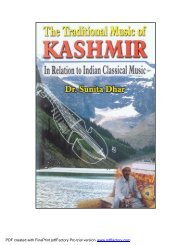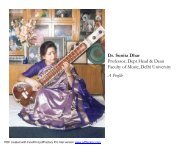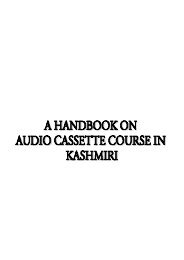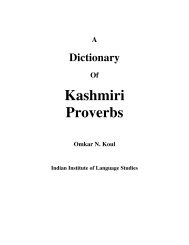Introductory Pages - An Introduction to Spoken Kashmiri
Introductory Pages - An Introduction to Spoken Kashmiri
Introductory Pages - An Introduction to Spoken Kashmiri
Create successful ePaper yourself
Turn your PDF publications into a flip-book with our unique Google optimized e-Paper software.
Bunjwali<br />
<strong>An</strong> <strong>Introduction</strong> <strong>to</strong> <strong>Spoken</strong> <strong>Kashmiri</strong><br />
by Braj B. Kachru<br />
Out of the languages of the Dardic Group, <strong>Kashmiri</strong> came under the direct influence of Sanskrit<br />
and later Prakrits, and much later under Persian and Arabic.<br />
Dialects of <strong>Kashmiri</strong><br />
There has been no serious dialect research on <strong>Kashmiri</strong>. The outdated and rather tentative dialect<br />
classification of <strong>Kashmiri</strong> by Grierson continues <strong>to</strong> be used in current literature. Adopting the<br />
same framework, the dialects of <strong>Kashmiri</strong> may be grouped along two dimensions: (a) those<br />
dialects which are area-defined, and (b) those dialects which are defined in terms of the user.<br />
The list of area-defined dialects given in Grierson and in the Census of India 1961 are not<br />
identical. In the latter, the following dialects are listed: Bunjwali (550); Kishtwari (11,633);<br />
Poguli (9,508); Shiraji-<strong>Kashmiri</strong> (19,978); Kaghani (152); and Kohistani (81). Grierson, on the<br />
other hand, claims that <strong>Kashmiri</strong> has “only one true dialect—Kashtawari” and “a number of<br />
mixed dialects such as Poguli, Siraji of Doda and Rambani .... Farther east, over the greater part<br />
of the Riasi District of the State, there are more of these mixed dialects, about which nothing<br />
certain is known, except that the mixture is rather between <strong>Kashmiri</strong> and the Chibhali form of<br />
Lahanda.” [10]<br />
There has been no linguistically-oriented field work on the dialects of <strong>Kashmiri</strong>. The above<br />
classifications, determined by both Grierson and the Census of India, 1961, seem <strong>to</strong> be arbitrary<br />
and subjective. Perhaps further investigation may show that Kashtawari is the only dialect of<br />
<strong>Kashmiri</strong>,as is claimed by Grierson, and that the other varieties are (a) those based on the<br />
variations of village speech, (b) those based on Sanskrit and Persian/Arabic influences, and (c)<br />
those based on professions and occupations of speakers.<br />
In some studies, the above (b) have been termed the religious dialects of <strong>Kashmiri</strong> (i.e., Hindu<br />
<strong>Kashmiri</strong> and Muslim <strong>Kashmiri</strong>).<br />
Geographical Dialects<br />
In current literature, the following are generally treated as the area-defined dialects of <strong>Kashmiri</strong>:<br />
1. Kashtawari : This is spoken in the Valley of Kashtawār which lies on the southeast of<br />
Kashmir, on the upper Chinab River. It shows the deep influence of the Pahāri and the<br />
Lahandā dialects, and is written in the Takri characters.<br />
2. Poguli: This is spoken in the valleys of Pogul, Paristan and Sar. These valleys lie <strong>to</strong> the<br />
west of Kashtawar and <strong>to</strong> the south of the Pir Pantsal (Panchal) range. Bailey has used the<br />
cover-term Poguli for the language of this area. It is mixed with the Pahari and<br />
Lahanda dialects.<br />
© 2006 Braj B. Kachru (http://kachru.com) 3<br />
http://koshur.org/<strong>Spoken</strong><strong>Kashmiri</strong><br />
550


